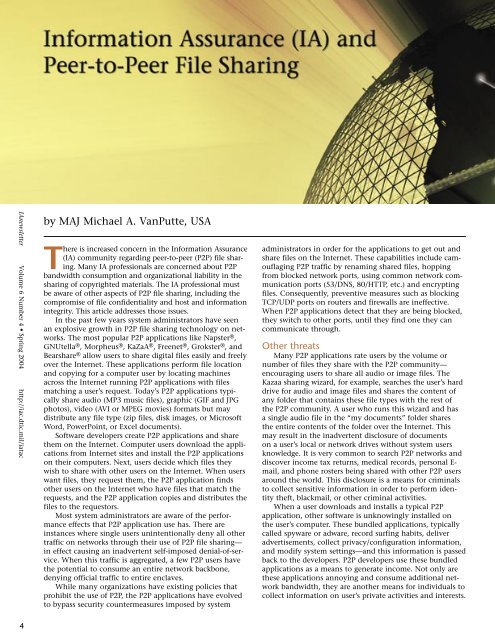Download - IAC - Defense Technical Information Center
Download - IAC - Defense Technical Information Center
Download - IAC - Defense Technical Information Center
Create successful ePaper yourself
Turn your PDF publications into a flip-book with our unique Google optimized e-Paper software.
IAnewsletter Volume 6 Number 4 • Spring 2004 http://iac.dtic.mil/iatac<br />
by MAJ Michael A. VanPutte, USA<br />
There is increased concern in the <strong>Information</strong> Assurance<br />
(IA) community regarding peer-to-peer (P2P) file sharing.<br />
Many IA professionals are concerned about P2P<br />
bandwidth consumption and organizational liability in the<br />
sharing of copyrighted materials. The IA professional must<br />
be aware of other aspects of P2P file sharing, including the<br />
compromise of file confidentiality and host and information<br />
integrity. This article addresses those issues.<br />
In the past few years system administrators have seen<br />
an explosive growth in P2P file sharing technology on networks.<br />
The most popular P2P applications like Napster ® ,<br />
GNUtella ® , Morpheus ® , KaZaA ® , Freenet ® , Grokster ® , and<br />
Bearshare ® allow users to share digital files easily and freely<br />
over the Internet. These applications perform file location<br />
and copying for a computer user by locating machines<br />
across the Internet running P2P applications with files<br />
matching a user’s request. Today’s P2P applications typically<br />
share audio (MP3 music files), graphic (GIF and JPG<br />
photos), video (AVI or MPEG movies) formats but may<br />
distribute any file type (zip files, disk images, or Microsoft<br />
Word, PowerPoint, or Excel documents).<br />
Software developers create P2P applications and share<br />
them on the Internet. Computer users download the applications<br />
from Internet sites and install the P2P applications<br />
on their computers. Next, users decide which files they<br />
wish to share with other users on the Internet. When users<br />
want files, they request them, the P2P application finds<br />
other users on the Internet who have files that match the<br />
requests, and the P2P application copies and distributes the<br />
files to the requestors.<br />
Most system administrators are aware of the performance<br />
effects that P2P application use has. There are<br />
instances where single users unintentionally deny all other<br />
traffic on networks through their use of P2P file sharing—<br />
in effect causing an inadvertent self-imposed denial-of-service.<br />
When this traffic is aggregated, a few P2P users have<br />
the potential to consume an entire network backbone,<br />
denying official traffic to entire enclaves.<br />
While many organizations have existing policies that<br />
prohibit the use of P2P, the P2P applications have evolved<br />
to bypass security countermeasures imposed by system<br />
administrators in order for the applications to get out and<br />
share files on the Internet. These capabilities include camouflaging<br />
P2P traffic by renaming shared files, hopping<br />
from blocked network ports, using common network communication<br />
ports (53/DNS, 80/HTTP, etc.) and encrypting<br />
files. Consequently, preventive measures such as blocking<br />
TCP/UDP ports on routers and firewalls are ineffective.<br />
When P2P applications detect that they are being blocked,<br />
they switch to other ports, until they find one they can<br />
communicate through.<br />
Other threats<br />
Many P2P applications rate users by the volume or<br />
number of files they share with the P2P community—<br />
encouraging users to share all audio or image files. The<br />
Kazaa sharing wizard, for example, searches the user’s hard<br />
drive for audio and image files and shares the content of<br />
any folder that contains these file types with the rest of<br />
the P2P community. A user who runs this wizard and has<br />
a single audio file in the “my documents” folder shares<br />
the entire contents of the folder over the Internet. This<br />
may result in the inadvertent disclosure of documents<br />
on a user’s local or network drives without system users<br />
knowledge. It is very common to search P2P networks and<br />
discover income tax returns, medical records, personal E-<br />
mail, and phone rosters being shared with other P2P users<br />
around the world. This disclosure is a means for criminals<br />
to collect sensitive information in order to perform identity<br />
theft, blackmail, or other criminal activities.<br />
When a user downloads and installs a typical P2P<br />
application, other software is unknowingly installed on<br />
the user’s computer. These bundled applications, typically<br />
called spyware or adware, record surfing habits, deliver<br />
advertisements, collect privacy/configuration information,<br />
and modify system settings—and this information is passed<br />
back to the developers. P2P developers use these bundled<br />
applications as a means to generate income. Not only are<br />
these applications annoying and consume additional network<br />
bandwidth, they are another means for individuals to<br />
collect information on user’s private activities and interests.<br />
4

















